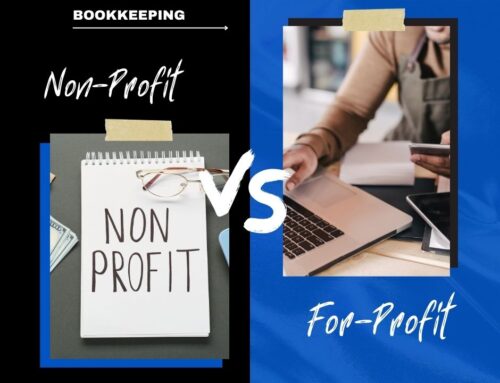The accounting cycle is a critical component of accurate bookkeeping and healthy financial management. When properly applied, the accounting cycle provides the information required to make sound business decisions.
What is the accounting cycle?
It’s the system for recording, processing, analyzing, and summarizing financial data in a consistent procedure. The accounting cycle begins with a transaction and ends closing entries on financial statements.
It’s the bookkeeper’s responsibility to manage the tasks associated with the accounting cycle. But as a business owner, you need to have a basic understanding of how this works as well.
Stages in the Accounting Cycle
Generally, there are eight different stages in the accounting cycle.
Depending on who you ask, this number can vary from 6-10. Each small business bookkeeper might have a slightly different name for a stage. Some accountants combine these steps while others break them up into extra ones. To keep it simple, we’re going to focus on the eight most common steps in the accounting cycle.
Step #1: Transactions
A transaction is the first stage of the accounting cycle. Without financial transactions, there wouldn’t be anything to keep track of. Examples of transactions include:
- Sales revenue
- Business expenses
- Debt payments
- Acquisition of assets
All these examples would trigger the beginning of the accounting cycle.
Step #2: Journal Entries
Once a transaction occurs, it needs to be recorded. The next step of the accounting cycle is to document those entries in the company’s accounting journal. All journal entries are recorded in chronological order.
Journal entries should be posted using double-entry bookkeeping. Whenever one account is debited, another must be credited. The debits and credits of your journal entries always need to balance.
Step #3: General Ledger
After the journal entries are recorded, the next step of the accounting cycle is posting those entries to the general ledger.
The general ledger is essentially a summary of all transactions that are grouped by accounts. Balances of each ledger account change based on what gets recorded.
- Assets
- Liabilities
- Shareholders’ Equity
- Operating Revenue
- Operating Expenses
- Non-operating Revenues and Gains
- Non-operating Expenses and Losses
It’s common to arrange the general ledger based on these seven classifications.
Step #4: Trial Balance
The total balance for each general ledger account needs to be calculated at the end of the accounting period. Depending on the company, accounting periods can be each month, quarter, or year.
The purpose of the trial balance report is simply to validate that the total debits are the same as the total credits. You won’t be checking the accuracy of the journal entries during the trial balance stage of the accounting cycle, but wrong-way balances will be immediately evident.
Step #5: Adjusted Journal Entries
While journal entries are recorded chronologically, you need to make sure that the revenues and expenses are assigned to the correct accounting period. This is required if you’re using an accrual-based accounting system.
These are four different types of journal entry adjustments:
- Accrued Expenses
- Accrued Revenues
- Deferred Expenses
- Deferred Revenues
For example, income paid but not yet earned would not be posted in the trial balance. This deferred revenue would be recorded during the adjusted journal entries stage of the cycle.
Step #6: Adjusted Trial Balance
Once the adjusted journal entries have been posted, you must adjust the trial balance as well.
This has the same purpose as the first time you generated the trial balance. Again, you need to validate that the credits and debits are equal after the entries were adjusted in the previous step.
Step #7: Financial Statements
Three reports will be generated using the correct numbers from the adjusted trial balance.
- Balance Sheet
- Income Statement
- Cash Flow Statement
For more information on these statements, review our guide on the three essential financial reports for small business bookkeeping.
Step #8: Closing Entries
All the revenue and expense accounts must be zeroed out and closed in the last stage of the process. Income statements are used to show a company’s performance during a specific time (the accounting period).
For these statements, you’ll start over from zero during the next accounting cycle.
The balance sheet account is not closed. That’s because a balance sheet is used to show your company’s financial position at a specific time, as opposed to during a specific period (month, quarter, year).
Accounting Cycle Best Practices
Getting through the accounting cycle can be challenging for small business owners who have never done this before. This is especially true for growing businesses that need a more sophisticated bookkeeping system.
Here are some tips and best practices to keep in mind when you’re going through each step of the accounting cycle:
- Develop a standardized accounting procedure to ensure consistency during each stage of the accounting cycle.
- Keep a record of every transaction posted to the general ledger (purchase orders, invoices, etc.), and back it up using a cloud-based accounting solution.
- Maintain strong internal controls and segment duties to ensure accuracy while reducing the risk of fraud.
- Make sure that people with the appropriate levels of bookkeeping expertise are handling the steps of the accounting cycle.
- Consider using an outsourced bookkeeping service for improved accuracy.
- Leverage technology and small business bookkeeping software to streamline each stage of the cycle.
Following these guidelines will make your life easier on a daily, monthly, quarterly, and annual basis. It’s essential that you establish proper bookkeeping procedures immediately.
Conclusion
The accounting cycle can be a bit intimidating for small business owners without a background in bookkeeping or accounting.
The steps of the accounting cycle should always be handled by an expert. If you don’t have an in-house accounting team, you should consider working with an outsourced bookkeeping service.
Your outsourced bookkeeper will ensure accuracy and consistency throughout each stage of the cycle. Outsourced bookkeepers leverage the latest tools and technology.
Outsourcing your bookkeeping tasks will allow you to focus your time, energy, and resources on other areas of your business. Contact us here at Navitance for a consultation and tell us more about your small business bookkeeping needs. We would be happy to assist you.





